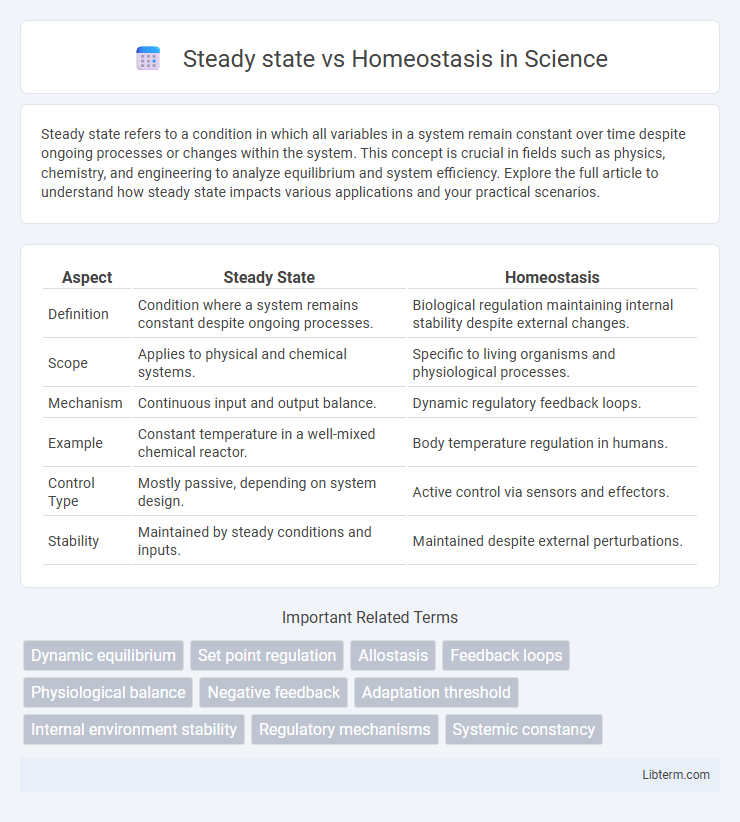Steady state refers to a condition in which all variables in a system remain constant over time despite ongoing processes or changes within the system. This concept is crucial in fields such as physics, chemistry, and engineering to analyze equilibrium and system efficiency. Explore the full article to understand how steady state impacts various applications and your practical scenarios.
Table of Comparison
| Aspect | Steady State | Homeostasis |
|---|---|---|
| Definition | Condition where a system remains constant despite ongoing processes. | Biological regulation maintaining internal stability despite external changes. |
| Scope | Applies to physical and chemical systems. | Specific to living organisms and physiological processes. |
| Mechanism | Continuous input and output balance. | Dynamic regulatory feedback loops. |
| Example | Constant temperature in a well-mixed chemical reactor. | Body temperature regulation in humans. |
| Control Type | Mostly passive, depending on system design. | Active control via sensors and effectors. |
| Stability | Maintained by steady conditions and inputs. | Maintained despite external perturbations. |
Introduction to Steady State and Homeostasis
Steady state refers to a dynamic condition where internal variables remain constant despite ongoing processes that strive to change them, commonly observed in physiological systems maintaining balance. Homeostasis specifically describes the regulatory mechanisms by which living organisms actively maintain stable internal environments, such as temperature, pH, and electrolyte balance, within narrow limits essential for survival. Both concepts emphasize stability, but homeostasis involves complex feedback loops and adaptive responses, while steady state may occur in non-biological systems without self-regulation.
Defining Steady State
Steady state refers to a condition in a system where variables remain constant over time despite ongoing processes that strive to change them, achieved through continuous input and output balancing. In physiology, steady state involves the maintenance of internal conditions, such as body temperature or pH level, that are stable but not necessarily optimal or ideal. Unlike homeostasis, which actively regulates and corrects deviations to maintain equilibrium within narrow limits, steady state represents a dynamic balance without a specific set point.
Understanding Homeostasis
Homeostasis is the dynamic process by which biological systems maintain stable internal conditions despite external environmental changes, ensuring optimal function and survival. Unlike steady state, which refers to a condition of constant change balanced by equal opposing forces, homeostasis involves active regulatory mechanisms such as negative feedback loops controlling temperature, pH, and glucose levels. Understanding homeostasis highlights the body's ability to detect deviations and initiate physiological responses to restore equilibrium, crucial for health and disease prevention.
Key Differences Between Steady State and Homeostasis
Steady state refers to a condition where a variable remains constant over time despite ongoing processes or inputs, often maintained by continuous energy expenditure. Homeostasis involves dynamic regulation of internal conditions within a narrow range to sustain life, typically through feedback mechanisms responding to environmental changes. The key difference lies in homeostasis actively restoring balance after disturbances, while steady state maintains equilibrium through constant input and output without necessarily correcting deviations.
Biological Examples of Steady State
Steady state in biology refers to the condition where a system maintains constant internal conditions through continuous energy input, distinct from homeostasis which involves dynamic regulation around set points. Examples include blood flow, where the heart pumps continuously to maintain circulatory stability, and the liver's metabolic processes that steadily detoxify substances. Cellular ATP levels remain in a steady state despite constant consumption and production, ensuring energy availability for various biochemical reactions.
Biological Examples of Homeostasis
Homeostasis in biology refers to the dynamic regulatory process that maintains internal stability within organisms despite external environmental changes. Examples include the human body's regulation of blood glucose levels through insulin and glucagon secretion, thermoregulation to maintain core temperature, and osmoregulation in freshwater fish to balance salt and water concentrations. Unlike steady state, which implies constant condition without change, homeostasis involves active feedback mechanisms that correct deviations from set points to preserve optimal physiological function.
Regulatory Mechanisms Involved
Steady state maintains internal stability by continuous energy input to counteract changes, primarily through dynamic regulatory mechanisms such as active transport and metabolic adjustments. Homeostasis involves sensor-effector feedback loops that detect deviations from set points and activate effectors to restore equilibrium, primarily governed by negative feedback controls. Both processes rely on complex signaling pathways, including hormonal and neural regulation, to sustain optimal physiological conditions despite external fluctuations.
Importance in Physiology and Health
Steady state and homeostasis are vital concepts in physiology that maintain internal stability in living organisms. Steady state refers to a constant internal environment achieved through continuous energy input, crucial for processes like oxygen delivery during exercise. Homeostasis involves dynamic regulation of physiological parameters such as body temperature, blood pH, and glucose levels, essential for health by preventing disease and ensuring optimal cellular function.
Implications for Disease and Disorders
Steady state and homeostasis both regulate internal conditions, but steady state involves constant energy input to maintain variables, while homeostasis refers to dynamic equilibrium with feedback mechanisms maintaining stability. Disruptions in homeostasis can lead to diseases such as diabetes, hypertension, and metabolic syndrome due to failure in feedback control. Understanding these processes is crucial for developing treatments targeting the restoration of physiological balance in chronic disorders.
Conclusion: Steady State vs Homeostasis
Steady state and homeostasis both describe conditions of internal stability but differ fundamentally in mechanisms and contexts; steady state refers to dynamic equilibrium maintained by continuous input and output, commonly in physical and chemical systems, while homeostasis involves biological regulatory processes actively maintaining stable internal conditions. Homeostasis is characterized by feedback mechanisms that detect and correct deviations from set points, crucial for organism survival. Understanding this distinction clarifies how living systems sustain life through complex control systems, whereas steady state applies broadly across natural and engineered systems.
Steady state Infographic

 libterm.com
libterm.com